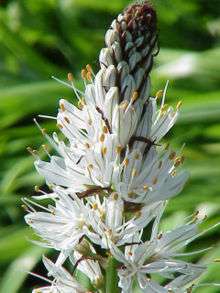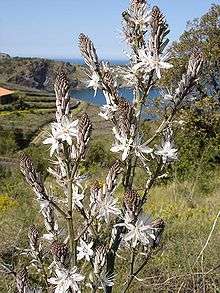Asphodelus
| Asphodelus | |
|---|---|
 | |
| White asphodel (Asphodelus albus) | |
| Scientific classification | |
| Kingdom: | Plantae |
| Clade: | Angiosperms |
| Clade: | Monocots |
| Order: | Asparagales |
| Family: | Asphodelaceae |
| Subfamily: | Asphodeloideae |
| Genus: | Asphodelus L. |
| Synonyms[1] | |
| |
Asphodelus is a genus of mainly perennial plants first described for modern science in 1753. The genus is native to temperate Europe, the Mediterranean, Africa, the Middle East, and the Indian Subcontinent, and now naturalized in other places (New Zealand, Australia, Mexico, southwestern United States, etc.).[1][2]
Asphodels are popular garden plants, which grow in well-drained soils with abundant natural light. Now placed in the family Asphodelaceae,[3] the genus was formerly included in the lily family (Liliaceae).[4]
Character
The plants are hardy herbaceous perennials with narrow tufted radical leaves and an elongated stem bearing a handsome spike of white or yellow flowers. Asphodelus albus and A. fistulosus have white flowers and grow from 1½ to 2 ft. high; A. ramosus is a larger plant, the large white flowers of which have a reddish-brown line in the middle of each segment.
Uses
The leaves are used to wrap burrata, an Italian cheese. The leaves and the cheese last about the same time, three or four days, and thus fresh leaves are a sign of a fresh cheese, while dried out leaves indicate that the cheese is past its prime.[5]
Mythology
In Greek legend the asphodel is one of the most famous of the plants connected with the dead and the underworld. Homer describes it as covering the great meadow (ἀσφόδελος λειμών), the haunt of the dead. It was planted on graves, and is often connected with Persephone, who appears crowned with a garland of asphodels. Its general connection with death is due no doubt to the greyish colour of its leaves and its yellowish flowers, which suggest the gloom of the underworld and the pallor of death. The roots were eaten by the poorer Greeks; hence such food was thought good enough for the shades. The asphodel was also supposed to be a remedy for poisonous snake-bites and a specific against sorcery; it was fatal to mice, but preserved pigs from disease. The Libyan nomads made their huts of asphodel stalks.
Poetry
The asphodel is mentioned by several poets in connection with the mythology of death, and by association, the afterlife - specifically the Isles of the Blessed and Elysium - part of the ancient Greek concept of the afterlife.
- Milton: "To embathe In nectared lavers strewed with asphodel."
- Pope: "Happy Souls who dwell In Yellow Meads of Asphodel, Or Amaranthine Bowers."
- Tennyson: "Others in Elysian valleys dwell, Resting weary limbs at last on beds of asphodel."
- Leonard Cohen: "But in his lapel, discreetly, he wore a sprig of asphodel."
- Longfellow: "He, who wore the crown of asphodels, Descending, at my door began to knock."[6]
- Barrett Browning: "As one who stands in dewless asphodel, Looks backward on the tedious time he had In the upper life."
- William Faulkner: "There asphodels are scattered through the night, Like ghosts of young beseeching hands." ONE WHO WAS LEFT LIVING, CHANSONS AU PRINTEMPS, handwritten with drawings, 1919, W. Faulkner, RFC
- Conrad Aiken: "Snowflake on asphodel—how clear, how bright / Snow's death on dying flower, yet both immortal"
- William Carlos Williams: "Asphodel, that greeny flower"
- Allen Ginsberg: "An Asphodel"
- Ezra Pound: "Canto XXI": "Danced there Athame, danced, and there Phaethusa/ With colour in the vein,/ Strong as with blood drink, once,/ With colour in the vein/ Red in the smoke-faint throat. Dis caught her up./ And the old man went on there/ beating his mule with an asphodel."
- Edgar Allan Poe: "and when, one by one, the white daisies shrank away, there sprang up in place of them, ten by ten of the ruby-red asphodel"
In popular culture
The powdered root of asphodel is mentioned as an ingredient in a sleeping potion in Harry Potter and the Philosopher's Stone by J. K. Rowling.[7]
In The Picture of Dorian Grey by Oscar Wilde, Lord Henry talks of old lovers: "I had buried my romance in a bed of asphodel."[8]
In Vladimir Nabokov's 1941 novel, The Real Life of Sebastian Knight, the protagonist's last novel bears the title The Doubtful Asphodel, obviously alluding to the plant's association with death.[9]
In Matthew Ward's translation of Albert Camus' The Stranger the plateau next to the beach where Mersault will shoot an Arab is "covered with yellowish rocks and the whitest asphodels set against the already hard blue of the sky".[10]
Etymology
The word is a loanword from Greek. Its original version is ἀσφόδελος.[11]
Systematics
There are 16 species in the genus.[12]
- Species[1]
- Asphodelus acaulis Desf. - Branched asphodel - Algeria, Morocco, Tunisia
- Asphodelus aestivus Brot. - Summer asphodel, also known as Common asphodel and Silver rod - southern Europe ( from Portugal to Turkey )
- Asphodelus albus Mill. - White asphodel, also known as Rimmed lichen - Mediterranean
- Asphodelus ayardii Jahand. & Maire - France, Spain, Italy, Algeria, Morocco, Tunisia, Canary Islands
- Asphodelus bakeri Breistr. - Western Himalayas of northern India, northern Pakistan, etc.
- Asphodelus bento-rainhae P.Silva - Spain, Portugal
- Asphodelus cerasiferus J.Gay - France, Spain, Sardinia, Algeria, Morocco, Tunisia
- Asphodelus fistulosus L. - Onion-leaved asphodel, also known as Onionweed - Mediterranean ( naturalized in New Zealand, Mexico, southwestern United States, etc. )
- Asphodelus gracilis Braun-Blanq. & Maire - Morocco
- Asphodelus lusitanicus Cout. - Spain, Portugal
- Asphodelus macrocarpus Parl. - Mediterranean
- Asphodelus ramosus L. - Branched asphodel - southern Europe, northern Africa, the Middle East and Canary Islands
- Asphodelus refractus Boiss. - North Africa and Arabian Peninsula from Mauritania + Morocco to Saudi Arabia
- Asphodelus roseus Humbert & Maire - Spain, Morocco
- Asphodelus serotinus Wolley-Dod - Spain, Portugal
- Asphodelus tenuifolius Cav. - Southeast Europe and northern Africa from the Mediterranean south to Mali, Chad, Sudan, Somalia; south-central Asia from Caucasus to India
- Asphodelus viscidulus Boiss. - North Africa, Middle East, Arabian Peninsula
- Formerly included
- Asphodelus luteus L. – synonym of Asphodeline lutea
Notes
- 1 2 3 Kew World Checklist of Selected Plant Families
- ↑ Altervista Flora Italiana, genere Asphodelus includes photos plus European distribution maps
- ↑ Angiosperm Phylogeny Group (2016). "An update of the Angiosperm Phylogeny Group classification for the orders and families of flowering plants: APG IV". Botanical Journal of the Linnean Society. 181 (1): 1–20. doi:10.1111/boj.12385.
- ↑ Bailey, L.H. & E.Z. Bailey. 1976. Hortus Third i–xiv, 1–1290. MacMillan, New York.
- ↑ Roberts, Genevieve (2 March 2011). "Burrata: Britain's new Big cheese". The Independent. Retrieved 7 September 2013.
- ↑ Shorter Oxford English dictionary, 6th ed. United Kingdom: Oxford University Press. 2007. p. 3804. ISBN 0199206872.
- ↑ Lord, E. The heartbreaking truth behind Snape's first words to Harry in Harry Potter. Bustle.com. November 11, 2015.
- ↑ Oscar Wilde: The Picture of Dorian Gray. Chapter 8. The Literature Page.
- ↑ Meyer, P. Anglophonia and Optimysticism: Sebastian Knight’s Bookshelves. In: Dolinin, A., et al. (Eds.) Russian Literature and the West. Stanford, CA: Stanford Slavic Studies, 2008. 212-226.
- ↑ Camus, Albert. "The Stranger". translated by Matthew Ward. Vintage Books; New York, 1989. Page 49.
- ↑ "Greek Word Study Tool". Perseus.tufts.edu. Retrieved 2011-10-20.
- ↑ Lifante, Z. D. (1996). Pollen morphology of Asphodelus L.(Asphodelaceae): taxonomic and phylogenetic inferences at the infrageneric level. Grana, 35(1), 24-32.
References

External links

